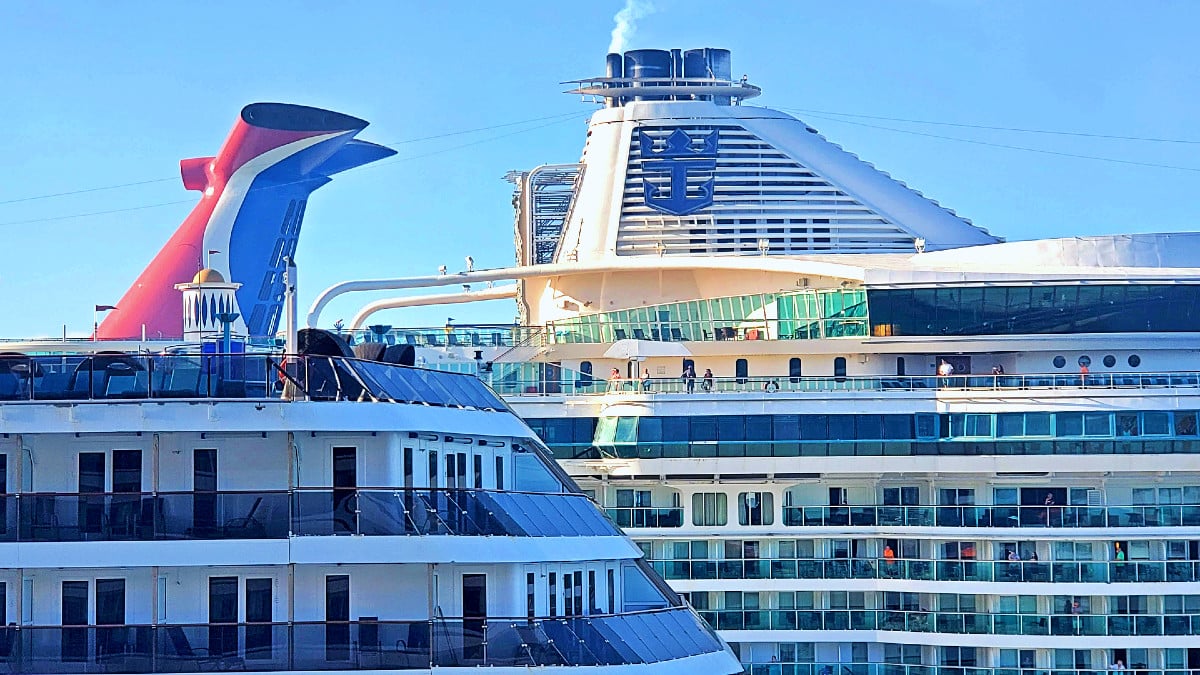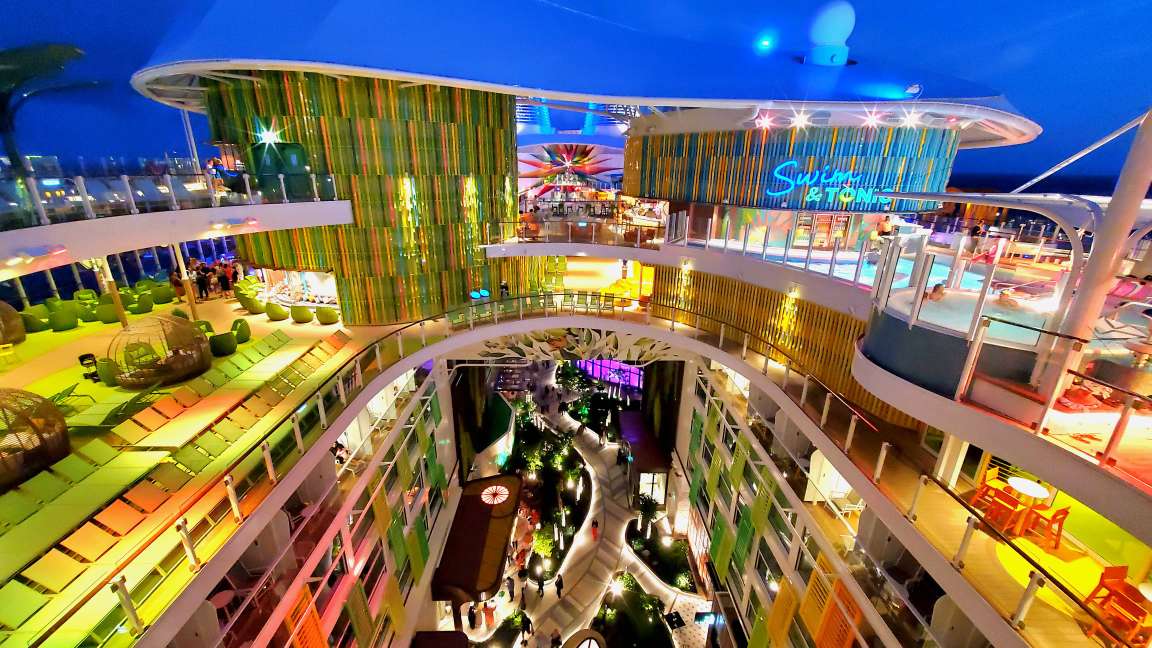Cruise ships have some of the most advanced technology in the world. And when it comes to health standards and cleanliness, they provide a level of sanitation that exceeds most land-based establishments.

If you only read the headlines from major news outlets, you would think that outbreaks on cruise ships are as commonplace as bad karaoke.
These headlines get eyeballs and clicks. They also tend to scare off those more sensitive to germs and illness.
After all, a cruise ship is a confined space. While these vessels are larger than ever, it’s easy to assume that illness and disease would thrive in a more enclosed environment. But there’s more to the story.
For some germaphobes, the thought of taking a cruise is laced with anxiety. And while no ship is 100% germ-free, in this article we will dive into the advanced hygiene protocols that are found on today’s cruise ships.
Here are 10 things every germaphobe should know about today’s cruise ships:
1. Cruise ships are subject to thorough CDC health inspections
The crew on a cruise ship are always busy cleaning different areas of the vessel. They know that an unannounced inspection could happen any time the ship pulls into a U.S. port, and there’s a lot of pressure to keep everything sanitized properly.
The CDC (Center for Disease Control) utilizes the VSP (Vessel Sanitation Program) to limit the spread of gastrointestinal illnesses on cruise ships operating from U.S. ports. Up to twice a year, the VSP conducts surprise inspections.
Inspectors closely examine key areas of the ship, including food handling and storage areas (kitchens, buffets, refrigerators), water treatment systems (drinking and pool water), sewage disposal systems, and medical facilities.
Each inspected ship received a sanitation score that is publicly on the CDC website https://www.cdc.gov/nceh/vsp/default.htm.
So far this year, the average score of cruise ships inspected is 94.3, with 7 ships receiving a perfect score of 100.

2. Handwashing protocols are more rigorous than ever
If you’ve been on a cruise ship lately, you understand this point. Cruise lines have always encouraged handwashing before entering dining venues like the buffet area and main dining room.
Today, it’s not uncommon to have a crew member stationed at the entrance of the buffet to highlight this importance.
Whether it’s the resounding chorus of “Washy washy!” or the crew member singing about washing your hands as they don a brightly colored costume, it’s almost impossible for a passenger to walk into an eating area without being guilt-tripped into washing up first.
It used to be that a crew member would just pour what seemed like half a gallon of hand sanitizer in your hands, but now washing hands with soap and water has proven more effective at keeping a clean environment.
On a recent cruise on Royal Caribbean’s Icon of the Seas, there was a very energetic and vocal crew member who sang popular tunes to words like, “Everybody wash your hands”. People loved it and I never saw one person walk by with hands uncleansed.
I don’t remember ever walking into Golden Corral and being encouraged to wash my hands first.

3. Norovirus is more common on land than on a cruise ship
This stomach illness has impacted cruise travelers from time to time. Recently there have been reports of a norovirus outbreak on a Royal Caribbean and Princess cruise ship.
So, are cruise ships rife with this gastrointestinal virus? You hear about them on the news because cruise lines are required to report to the CDC when 2% of passengers/crew members are sick. If the number reaches 3%, the CDC publishes a report on their website. No land based hotels, schools etc. have these requirements. This is why you hear about cases on cruise ships and rarely on land.
In reality, the CDC estimates far less than 1% of yearly U.S. norovirus cases happen on cruise ships. You just never see the other 99% show up in your newsfeed because it’s not required that they get reported.
4. Ships have advanced air filtration for cabins and public spaces
Cruise lines have take some huge steps forward with air quality improvements. Most newer ships have HEPA filters for individual cabins and around other parts of the ship.
HEPA filters can trap particles as small as .03 microns, making them capable of capturing airborne particles and viruses.
Here are just a few examples of what cruise lines are using to help keep the air found interior spaces clean.
- Norwegian Cruise Line Holdings announced a partnership with AtmosAir Solutions to install H13 HEPA filters across all the ships within its brand.
- Virgin Voyages uses AtmosAir’s ionization system to electrically charge particles in the air and remove any airborne contaminants.
- Royal Caribbean uses air filtration in public areas, stating that there are up to 15 air changes every hour in public spaces on their ships.

5. The water is purified through several methods
I’ve had the privilege of getting behind-the-scenes tours of cruise ship facilities. The treatment of water on board is one of the most fascinating things that most passengers have no idea is even happening.
Modern cruise ships use advanced treatment systems for wastewater to lessen any impact on the environment. But they also use Reverse Osmosis, ultraviolet light, and ozone to disinfect drinking water.
This is what makes it safe to drink water from your stateroom bathroom sink. They even add some minerals to help make it taste better.
Cruise ships can generate water from seawater by way of Reverse Osmosis or evaporation, and they can often hold half a million gallons at a time.
From the drinking water to the pool water, it’s safe and free of harmful bacteria.
6. Food safety is a priority
Kitchens on a cruise ship are the cleanest kitchens I’ve seen. But I’m not a health inspector. Still, these areas of the ship go through strict regulations that are examined by health inspectors.
Everything from food handling to storage and sanitation are inspected regularly. The kitchen crew is trained in food handling to minimize contamination, food is stored at the proper temperature to prevent bacteria growth, and kitchens are cleaned frequently.

7. Sick passengers are quarantined to prevent spread of illness
If a passenger gets especially sick, they’ll likely be isolated in their cabin to prevent further spread. The medical team will also perform contact tracing to identify anyone who may have been in close contact with the sick passenger.
Depending on the illness and risk of transmission, these close contacts may be quarantined in their cabins for a period of time.
Cruise lines take these measures very seriously, and they are required to report outbreaks to the CDC. It might be a huge inconvenience – especially when on vacation–, but it’s a vital step in preventing the spread of illness and ensuring everyone’s safety onboard.
And don’t’ forget, passengers fill out a health questionnaire just to get on board and go through a light screening ahead of time. This was enforced much more a few years ago but is still part of the boarding process.
8. Most of the ship is disinfected at night
High-touch surfaces in common areas like railings, elevator buttons, and door handles are frequently disinfected throughout the day with hospital-grade disinfectants.
At night, things really get ramped up with the cleaning process and an even more thorough wipe down.
The reason the deck chairs on lido deck get put away at night is so the crew can clean the deck. Also, this is when the pools and hot tubs get cleaned as well. On some ships the pools are deep cleaned every 2 to 3 days.
Public areas get a more thorough cleaning at night to minimize interference with passengers. This is when the floor scrubbing or carpet shampooing would get done.

9. Passengers are constantly reminded of good hygiene
Whether it’s on your stateroom TV or announcements made around the ship, you are constantly reminded to wash your hands, cover your mouth when you cough, and a myriad of other hygiene helps.
And the biggest help to combat the spread of germs is the behavior of passengers. After all, common sense is not so common to everyone. Some might need some helpful reminders now and then to keep their germs to themselves.
10. These are the “Germiest” places on a cruise ship
Areas like the buffet, pool deck, elevator, kids club, and onboard fitness center can be the “germiest”. But these are also some of the most disinfected and sanitized by the crew because of that very fact.
Disinfectant wipes can be useful before using a lido deck lounge chair (especially the armrests) or when touching any door handles. But many of today’s ships have automatic doors or doors that slide open when you wave your hand in front of the sensor, eliminating another point of contact.
A true germaphobe might want to just take the stairs as often as possible, though. I do this most of the time anyway because it’s a good work out, and I don’t want to go to the gym on vacation. In general, elevators are a bit too tight a space for a germophobe anyway.
Read our Elevator Survival Guide article for tips on avoiding any craziness that can go with them.
![]()
Bottom Line
Germs are a part of life, and there’s no 100% way to eliminate the risk of getting them. I can certainly understand a potential cruiser’s anxiety over this topic. And if it’s too much of a concern, another type of vacation may be more suitable.
But when you break it down, a cruise ship offers more sanitation protocols and technology than most places on land. The only real issue is that there are a lot of people on board most ships.
A smaller ship cruise line or even all-inclusive cruise line offers more space per passenger to help ease these concerns.
A few smart packing choices will help too. Pack some travel-size hand sanitizer and disinfectant wipes for wiping down high-touch items in the cabin. I also like to pack some air freshener if I can. It might not kill any germs, but it can help keep the stateroom smelling fresh at least.
So, the next time you hear someone say that cruise ships are Petri dishes, point them to a few of these facts above. And then ask them if their favorite restaurant or hotel faces the same kind of scrutiny.



